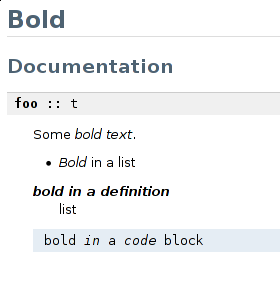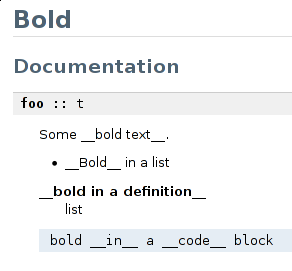Adding bold to Haddock (part 1)
Today I’m going to talk about and go through implementing bold support to Haddock. I am going to be writing this as I implement it, hopefully exposing the relevant parts and order in which I do so.
The aim of this post is to document the process and to serve as a reference to anyone in the future wishing to add such constructs, saving them time from looking what to change and where. This post will cover adding the new element to the parser, generating tests and making the new element pass the Hspec tests. Back-end changes will be covered in a future post.
Adding the type
First we need to add the appropriate type to Haddock. Haddock comments are all parsed into a Doc type, conveniently residing in Haddock.Types.
data Doc id
= DocEmpty
| DocAppend (Doc id) (Doc id)
| DocString String
| DocParagraph (Doc id)
| DocIdentifier id
| DocIdentifierUnchecked (ModuleName, OccName)
| DocModule String
| DocWarning (Doc id)
| DocEmphasis (Doc id)
| DocMonospaced (Doc id)
| DocUnorderedList [Doc id]
| DocOrderedList [Doc id]
| DocDefList [(Doc id, Doc id)]
| DocCodeBlock (Doc id)
| DocHyperlink Hyperlink
| DocPic Picture
| DocAName String
| DocProperty String
| DocExamples [Example]
deriving (Functor)I’ll just add DocBold (Doc id) and be on my way.
The next logical step would be to add some tests. As I wrote before, there are two test suites: Hspec tests, which are nice, quick to run, and test that the chunks of text parse into the Doc we want, and there are HTML tests which make sure that whole files parse into what we want (acting as XHTML back-end tests). Currently there are no tests for the LaTeX back-end.
In test/Haddock/ParseSpec.hs, I’ll quickly add a few rather trivial tests that are consistent with other markup. This is effectively where you have to decide on the behaviour you want to get out of your new construct as well as the delimiters. I decided for bold to use double-underscores, __, as opposed to * or a single _ because
It’s consistent with pretty much all common Markdown flavours as can be seen on John MacFarlane’s brilliant Babelmark 2
Double underscores are far less common in regular text. Escaping
*and_everywhere would get really tedious, really fast.
Hopefully any bike-shedding can be avoided although don’t hesitate to contact me if you have some great reasons for why it shouldn’t be __.
So with that, and a quick use of multiple-cursors on existing emphasis tests, we now have 102 examples, 4 failures. Before I proceed, HTML tests are in order as back-ends have to be updated for new elements, else they won’t know how to render them. We have to put some Haskell source files containing Haddock comments with bold in html-test/src and the expected XHTML source in html-test/ref. The files generated during the testing are put in html-test/out.
In this case we are lucky: emphasis is already implemented and has the same rules for where it can be position. This means we can simply write the test with emphasis, have Haddock generate the file with the right structure for us and then change all the <em> tags to <strong> tags without much fear of breaking anything.
So we start with this:

and get out a HTML file that reflects the structure we want. Just change the tags in the out file, move it to ref and update our test case doc.

and with this we get a (not so nice) failing HTML test diff:
64,66c64
< >Some <strong
< >bold text</strong
< >.
---
> >Some __bold text__.
70,72c68
< > <strong
< >Bold</strong
< > in a list
---
> > __Bold__ in a list
77,79c73
< ><strong
< >bold in a definition</strong
< ></dt
---
> >__bold in a definition__</dt
85,89c79
< > bold <strong
< >in</strong
< > a <strong
< >code</strong
< > block</pre
---
> > bold __in__ a __code__ block</preImplementation
This time we’ll only make changes in the parser. Back-end changes will be covered in the future.
Let us jump to the parser first. As I mentioned before, bold is very similar to emphasis in where it can appear. For reference, here’s code from the current emphasis element parser
-- | Emphasis parser.
--
-- >>> parseOnly emphasis "/Hello world/"
-- Right (DocEmphasis (DocString "Hello world"))
emphasis :: Parser (Doc RdrName)
emphasis = DocEmphasis . DocString . decodeB
<$> ("/" *> takeWhile1 (`notElem` "/\n") <* "/")With this spell in hand, let’s try to write a parser for bold:
-- | Bold parser.
--
-- >>> parseOnly bold "/Hello world/"
-- Right (DocBold (DocString "Hello world"))
bold :: Parser (Doc RdrName)
bold = DocBold . DocString . decodeB
<$> ("__" *> takeWhile1 (`notElem` "_\n") <* "__")There’s a rather obvious problem with this (and the emphasis parser): we can’t have bold text with an underscore inside of it, even if you were to escape it (escaping strings is done during parsing and not as post-processing). Unfortunately, this is to keep consistent with the old parser: it will eat up everything as a plain string until the first character of its delimiter. You can see this behaviour easily if you try to use ] in a title of a definition list or try to include > in a URL that uses the <url> syntax. I am considering changing this behaviour but not until I can gather more information about already existing documentation and whether any of it would change because of this. Perhaps I’ll even make a blog post with pretty pictures and diagrams.
Next we actually include the parser in the same places where emphasis is allowed:
p :: Parser (Doc RdrName)
p = mconcat <$> some (charEscape <|> monospace d <|> anchor <|> identifier d
<|> moduleName <|> picture <|> url <|> bold
<|> emphasis <|> encodedChar <|> string' <|> skipChar)where p is just a function bound in a where inside of a larger parser.
Let’s run Hspec tests.
102 examples, 0 failuresAwesome. With this we need to dive into the back-ends, which will be covered in a future post. Look forward to it.